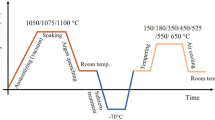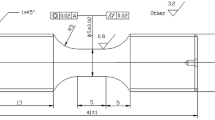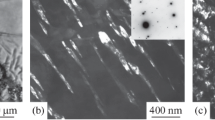Conclusions
-
1.
HTTMT intensifies two-phase decomposition of martensite in the process of quenching (increases the amount of low-carbon martensite) and favors partial transformation by the intermediate mechanism in the steels investigated.
-
2.
HTTMT affects the tempering of martensite. It inhibits single-phase decomposition and increases the stability of the two-phase condition of the solid solution. During tempering after HTTMT the tetragonal solid solution is retained to higher temperatures. This may be one of the reasons that the effect of HTTMT is retained at high tempering temperatures.
-
3.
The good combination of the mechanical properties after HTTMT is due to the fragmented stable structure of martensite, the interaction of carbon with defects, and the optimal redistribution of carbon in the martensite crystals.
-
4.
The changes in the structure during HTTMT are resistant and retained at high tempering temperatures and during repeated heat treatment.
Similar content being viewed by others
Literature cited
M. L. Bernshtein, V. A. Zaimovskii, and L. M. Kaputkina, Metal. i Term. Obrabotka Metal., No. 5 (1967).
L. M. Utevskii and F. R. Khashimov, Materials of the Conference on Increasing the Strength of Structural Steel and Alloys [in Russian], MDNTP (1966).
M. L. Bernshtein and I. I. Zlochevskaya, Izv. Akad. Nauk SSSR, Metally, No. 5 (1966).
A. P. Gulyaev and A. S. Shigarev, Metal. i Term. Obrabotka Metal., No. 5 (1961); No. 4 (1963).
M. L. Bernshtein et al., Metal. i Term. Obrabotka Metal., No. 4 (1966).
L. I. Lysak and Ya.N. Vovk, Fiz. Metal. i Metalloved.,19 (1965).
P. Winchel and M. Cohen, Trans. Am. Soc. Met.,55 (1962).
G. V. Kurdyumov, Fiz. Metal. i Metalloved.,19 (1966).
G. V. Kurdyumov et al., in: Problems of Physics of Metals and Metal Science [in Russian], No. 2, Izd. AN UkrSSR, Kiev (1950).
V. I. Sarrak, S. O. Suvorova, and R. I. Éntin, Izv. Akad. Nauk SSSR, Metally, No. 4 (1965).
L. I. Kogan et al., in: Problems of Metal Science and Physics of Metals, No. 38, Central Scientific-Research Institute of Ferrous Metallurgy [in Russian], Metallurgiya, Moscow (1968).
L. M. Utevskii and F. R. Khashimov, Byull. TsNIIChM, No. 6.
R. I. Éntin, L. I. Kogan, et al., in: Problems of Metal Science and Physics of Metals, No. 36, Central Scientific-Research Institute of Ferrous Metallurgy [in Russian], Metallurgiya, Moscow (1964).
S. Z. Bokshtein, Structure and Mechanical Properties of Alloyed Steel [in Russian], Metallurgizdat, Moscow (1954).
M. L. Bernshtein, R. Goller, and I. Vyborzhil, Fiz. Metal. i Metalloved.,24, No. 3 (1967).
Additional information
Moscow Institute of Steel and Alloys. Translated from Metallovedenie i Termicheskya Obrabotka Metallov, No. 12, pp. 34–40, December, 1969.
Rights and permissions
About this article
Cite this article
Bernshtein, M.L., Kaputkina, L.M. & Kanev, V.P. Martensite in silicon steels obtained by HTTMT. Met Sci Heat Treat 11, 958–963 (1969). https://doi.org/10.1007/BF00654932
Issue Date:
DOI: https://doi.org/10.1007/BF00654932




